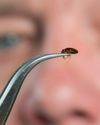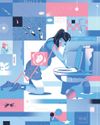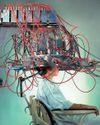
WHAT IS THE FIBONACCI SEQUENCE?
1 , 1, 2, 3, 5, 8, 13, 21… The Fibonacci sequence. Every number in the sequence is generated by adding together the two previous numbers. So, the next Fibonacci number is 13 + 21 = 34. They are the simplest example of a recursive sequence, where each number is generated by an equation in the previous numbers in the sequence. Hidden inside this sequence is another important number in mathematics: the golden ratio. Denoted by the Greek letter phi, it is a number like pi that has an infinite decimal expansion with no patterns. It starts phi = 1.61803… It’s defined as the ratio of a rectangle of dimensions A x B where the ratio A/B is equal to (A + B)/A. This is regarded by many artists as the perfect proportion for a canvas. If you divide a number in the Fibonacci sequence by the previous number in the sequence (for example, 5/3) then this fraction gets closer and closer to the golden ratio as you take larger and larger Fibonacci numbers. There’s a formula for the Fibonacci numbers involving the golden ratio that avoids having to calculate all the previous numbers. There are still mysteries about these numbers. For example, are there infinitely many Fibonacci numbers that are also prime numbers? Like 2, 3, 5 and 13. We only know 51 Fibonacci primes, but could there be an infinite amount?
WHY ARE THEY SO IMPORTANT?
Denne historien er fra July/August 2022-utgaven av Very Interesting.
Start din 7-dagers gratis prøveperiode på Magzter GOLD for å få tilgang til tusenvis av utvalgte premiumhistorier og 9000+ magasiner og aviser.
Allerede abonnent ? Logg på
Denne historien er fra July/August 2022-utgaven av Very Interesting.
Start din 7-dagers gratis prøveperiode på Magzter GOLD for å få tilgang til tusenvis av utvalgte premiumhistorier og 9000+ magasiner og aviser.
Allerede abonnent? Logg på

TAKE IT SLOW
Slow running is a fitness trend with some hard and fast science behind it

Physics, AI and music share a common thread. You just have to know where to look
Studying science can lead you in many directions and open doors to unexpected possibilities along the way

BED BUGS VS THE WORLD
When bloodthirsty bed bugs made headlines for infesting Paris Fashion Week in 2023, it shone a spotlight on a problem that's been making experts itch for decades: the arms race going on between bed bugs and humans

Kids are the key to understanding obesity. But we need more of their genes...
We can unravel the role that bodyweight plays in disease, but we need a bigger, more diverse, sample of genetic material to do so

COVID inquiry: What did we learn and what can we do better in future pandemics?
Masks, social distancing, lockdowns... how effective was the UK's response to the COVID-19 pandemic?

One hormone could be the key that unlocks a cure for morning sickness
The nausea and vomiting that, in extreme cases, can endanger mothers and babies might soon be just a memory

THE WORLD'S WEIRDEST CREATURES
Under the sea and upon the land, some animals look - to us - pretty strange...

WHEN MIND AND MACHINE COLLIDE
First, Elon Musk wanted to make electric cars ubiquitous, then he wanted to make space exploration a private enterprise. Now, with Neuralink, his newest venture, Musk hopes to merge humans and artificial intelligence. Turns out, it might not be such a crazy idea...

COME OUT OF YOUR SHELL
Social anxiety is more than just being shy. It's a phobia born out of our evolutionary past. But that raises a puzzling question: why do so many of us fear human interaction when we're supposed to be the most sociable species on the planet?

SPACE ODDITIES
Take a tour of the weirdest spots in the universe, where the 'normal' rules don't apply. Places that squeeze time, blow bubbles and even rain glass... sideways